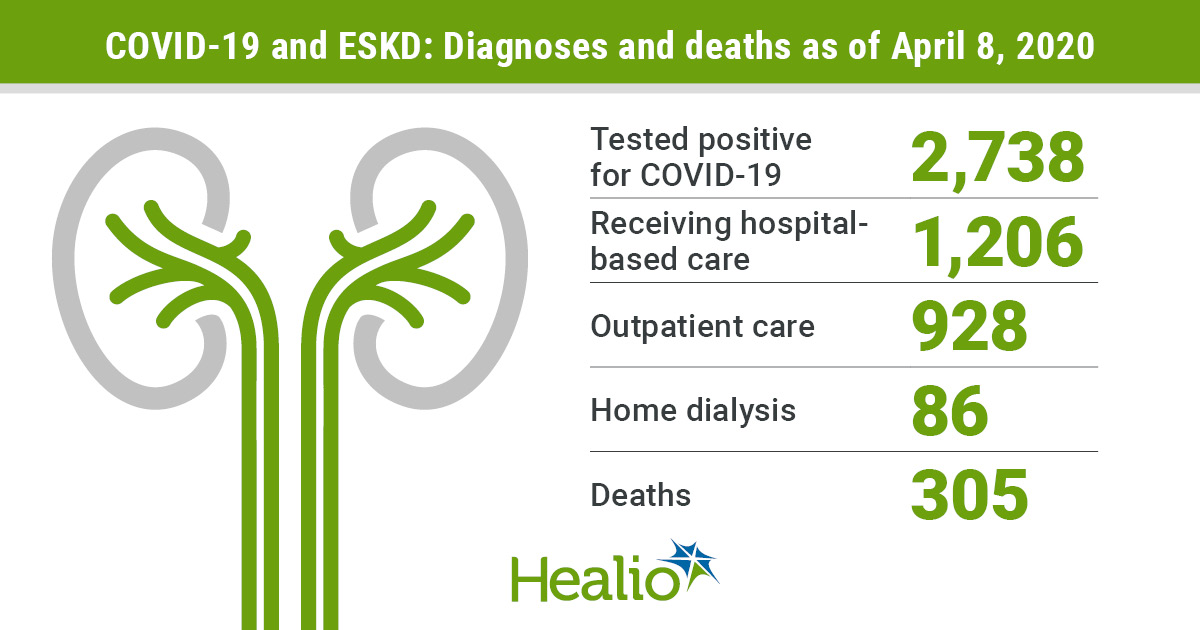Latest data show 305 dialysis patient deaths due to COVID-19 in the US
Click Here to Manage Email Alerts
Data released by Kidney Community Emergency Response as of April 8 shows 305 patients on dialysis in the United States have died from COVID-19.
The data, released during a Nephrologists Transforming Dialysis Safety-sponsored webinar “COVID-19: Considerations in the Home Dialysis Setting” on April 9, also showed that 2,738 patients on dialysis have tested positive for the virus.
“What you can clearly see here is that, like the general population, New York and New Jersey are some of the hardest hit areas for the COVID-19 virus” for patients with ESKD, webinar moderator Jeffrey Perl, MD, said as he reviewed state-by-state results. “This is something that is happening across the country.”
The Kidney Community Emergency Response (KCER) data also showed 6,592 patients on dialysis have been tested for the COVID-19 virus, and 132 patients have recovered.

The information was gathered by KCER from the 18 ESRD Networks, Perl said, which are government- and dialysis provider-funded organizations that monitor the quality of kidney care in the United States.
A nephrologist at St. Michael’s Hospital in Toronto, Canada, and an associate professor of medicine at the University of Toronto, Perl told attendees during the hour-long webinar that patients on home dialysis have a number of advantages in limiting their exposure to the COVID-19, virus including fewer trips to the dialysis clinic, fewer interactions with health care workers and an easier task in adhering to social distancing measures.
Two ways to move more of the incident ESKD population – those starting new on dialysis – to home include prescribing peritoneal dialysis (PD) for patients with acute kidney injury, and building a pathway for patients who receive their first dialysis in the emergency room to consider urgent start PD. Both approaches offer ways to avoid placing patients in the outpatient dialysis clinic, Perl said.
“We fundamentally believe we can lower the risk of exposure through home-based care,” he said.
At the Seattle-based Northwest Kidney Centers (NKC), where clinicians learned on Feb. 28 that the dialysis organization had the first COVID-19 patient death in the country, Jayson Hood, RN, the clinical director for the Home Program, Special Care Unit and Seattle Kidney Center, said staff members looked at the best ways to reduce face-to-face meetings between home patients and medical staff.
“Home patients were coming into the clinic two to three times a month for review. We felt we needed to limit those visits” because of the risk of spreading the virus. Instead, the home dialysis staff worked on the following three-pronged approach:
- set up "quick visits" for blood draws, administer medicines and give the patient any needed home dialysis supplies;
- conduct monthly patient assessments via telephone; and
- expedite the use of telemedicine and telehealth to give home patients a safer environment.
“We all know that life before COVID-19 and after COVID-19 will not be the same,” NKC CEO Suzanne Watnick, MD, told attendees. “New infection control techniques that we are developing now may help us reduce the risk of infections in the future.”
While many infection control practices remain similar to outpatient dialysis delivery, Shannon Novosad, MD, MPH, a medical officer with the Dialysis Safety Team in the division of health care quality promotion at the CDC, offered the following recommendations to limit risk for home patients:
Masks should be used during PD exchanges to reduce the risk of contamination of the PD catheter while the transfer set is open. “In countries such as the U.K., it is not usual practice for patients and nurses to wear masks during a PD exchange unless upper respiratory tract symptoms are present,” Novosad said.
If masks are used, staff should “have discussions with patients and care partners about mask conservation strategies,” she told attendees. “Consider reusing masks unless they are visibly wet or soiled. Discuss performing exchanges without masks if no respiratory symptoms are present.”
The CDC remains undecided as to how many times masks can be reused.
“That’s a time period we don’t yet understand well,” Novosad said. Family members should also be wearing masks during a PD exchange, she noted.
Deliveries of home supplies should be accepted without in-person contact whenever possible; supplies can be left in a safe spot outside the house, Novosad said.
“Otherwise, patients should stay at least 6-feet away from the delivery person,” she said. After receiving deliveries, patients should wash their hands with soap and water for 20 seconds.
Some regulatory questions remain about how dialysis staff can care for home patients in the midst of the pandemic, Jeffrey Silberzweig, MD, CEO of the Rogosin Institute, told attendees. “Do we still need monthly labs drawn on patients who are stable?” he asked attendees, and said clinicians are awaiting an answer from CMS.
Questions also remain about dialysis providers arranging transportation services for patients with COVID-19 without violating Stark laws that monitor conflict of interest. One of the biggest steps that Medicare could offer is paid partners for home dialysis, he said. “It might facilitate getting more patients to dialyze at home and reduce the risk of patients getting exposure to the virus in the dialysis centers,” Silberzweig said. – by Mark E. Neumann
Reference:
https://www.asn-online.org/ntds/resources/Webcast_2020_04_09_COVID-19.mp4
Disclosures: Perl reports he has served as a consultant and received speaker honoraria from Baxter Healthcare, DaVita Healthcare Partners and Fresenius Medical Care; has served as a consultant for LiberDi; and received speaker honoraria from Astra Zeneca, Dialysis Clinics Inc. and Satellite Healthcare. Hood, Novosad, Silberzweig and Watnick report no relevant financial disclosures.

